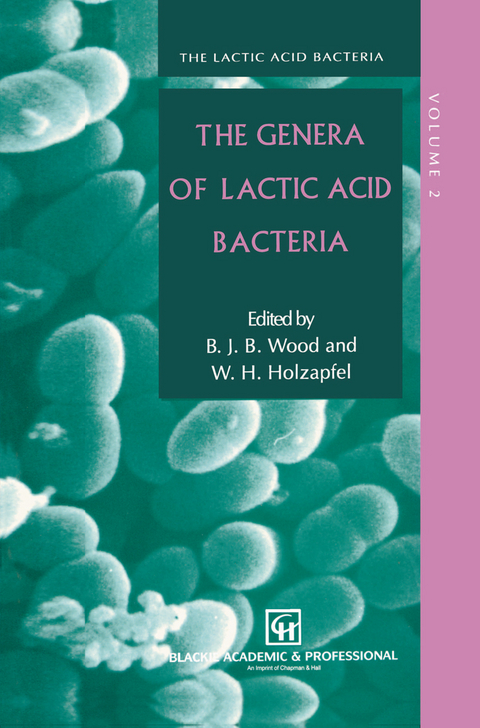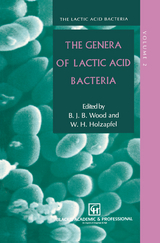The Genera of Lactic Acid Bacteria
Chapman and Hall (Verlag)
978-0-7514-0215-5 (ISBN)
1 Lactic acid bacteria in contemporary perspective.- 1.1 Introduction.- 1.2 Carbohydrate metabolism.- Acknowledgement.- Reference.- 2 Phylogenetic relationships of lactic acid bacteria.- 2.1 Introduction.- 2.2 The genera Lactobacillus, Leuconostoc and Pediococcus.- 2.3 The genus Carnobacterium.- 2.4 The genera Streptococcus, Lactococcus, Enterococcus and Vagococcus.- 2.5 The genera Aerococcus, Alloiococcus, Tetragenococcus and Atopobium.- 2.6 The genus Bifidobacterium.- Acknowledgement.- References.- 3 The genus Lactobacillus.- 3.1 Introduction.- 3.2 Grouping of lactobacilli.- 3.3 Description of the species.- Note added at proof.- Acknowledgement.- References.- 4 The genus Streptococcus.- 4.1 Introduction.- 4.2 Classification.- 4.3 Morphology.- 4.4 Cultural characteristics.- 4.5 Biochemistry/physiology.- 4.6 Cell wall composition.- 4.7 Genetics.- 4.8 Phylogeny.- 4.9 Importance of the genus.- 4.10 Identification.- 4.11 Isolation and enumeration.- 4.12 Maintenance and preservation.- 4.13 Species of the genus Streptococcus.- References.- 5 The genus Pediococcus with notes on the genera Tetratogenococcus and Aerococcus.- 5.1 Introduction.- 5.2 Morphology.- 5.2 Physiology.- 5.4 Genetic features.- 5.5 Immunochemistry.- 5.6 Historical aspects.- 5.7 Phylogenese relationships.- 5.8 Importance of the genus.- 5.9 Isolation and enumeration of pediococci.- 5.10 Maintenance and preservation of pediococci.- 5.11 Identification of pediococci.- 5.12 Description of species which comprise the genus Pediococcus.- 5.13 Concluding remarks.- Acknowledgements.- References.- 6 The genus Lactococcus.- 6.1 History.- 6.2 Morphology.- 6.3 Biochemistry and physiology.- 6.4 Genetics and genetic engineering.- 6.5 Phylogeny.- 6.6 Importance.- 6.7 Habitats.- 6.8 Enrichment and isolation.- 6.9 Identification and differentiation.- 6.10 Maintenance and preservation.- 6.11 Species of the genus Lactococcus.- References.- 7 The genus Leuconostoc.- 7.1 Introduction.- 7.2 Growth characteristics.- 7.3 Taxonomy.- 7.4 Genetics.- 7.5 Practical importance.- 7.6 Conclusion.- 7.7 List of species of the genus Leuconostoc.- References.- 8 The genus Bifidobacterium.- 8.1 General description of the genus.- 8.2 Phylogenetic relationships.- 8.3 The importance of the genus.- 8.4 List of species of the genus Bifidobacterium.- References.- 9 The genus Carnobacterium.- 9.1 History.- 9.2 Morphology.- 9.3 Biochemistry/physiology.- 9.4 Genetics.- 9.5 Phylogeny.- 9.6 Importance.- 9.7 Identification.- 9.8 Isolation and enumeration.- 9.9 Maintenance and preservation.- 9.10 Species of the genus Carnobacterium.- References.- 10 The genus Enterococcus.- 10.1 History.- 10.2 Phylogeny.- 10.3 Growth and isolation of enterococci.- 10.4 Phenotypic characteristics of the genus.- 10.5 Identification of the genus.- 10.6 Identification of enterococcal species.- 10.7 Description of species.- References.- 11 Spore-forming, lactic acid producing bacteria of the genera Bacillus and Sporolactobacillus.- 11.1 Introduction.- 11.2 General properties of the genus Bacillus and other spore-forming organisms.- 11.3 Bacillus species forming lactic acid.- 11.4 Sporolactobacillis inulinus.- 11.5 Phylogenetic relationships.- 11.6 Ecology and habitats of lactic acid producing spore-formers.- 11.7 Applications and products.- 11.8 Descriptions of the spore-forming lactic acid producing bacteria.- References.
| Reihe/Serie | The Lactic Acid Bacteria ; 2 |
|---|---|
| Zusatzinfo | XVIII, 398 p. |
| Verlagsort | London |
| Sprache | englisch |
| Maße | 155 x 235 mm |
| Themenwelt | Naturwissenschaften ► Biologie ► Mikrobiologie / Immunologie |
| Technik ► Lebensmitteltechnologie | |
| ISBN-10 | 0-7514-0215-X / 075140215X |
| ISBN-13 | 978-0-7514-0215-5 / 9780751402155 |
| Zustand | Neuware |
| Haben Sie eine Frage zum Produkt? |
aus dem Bereich




